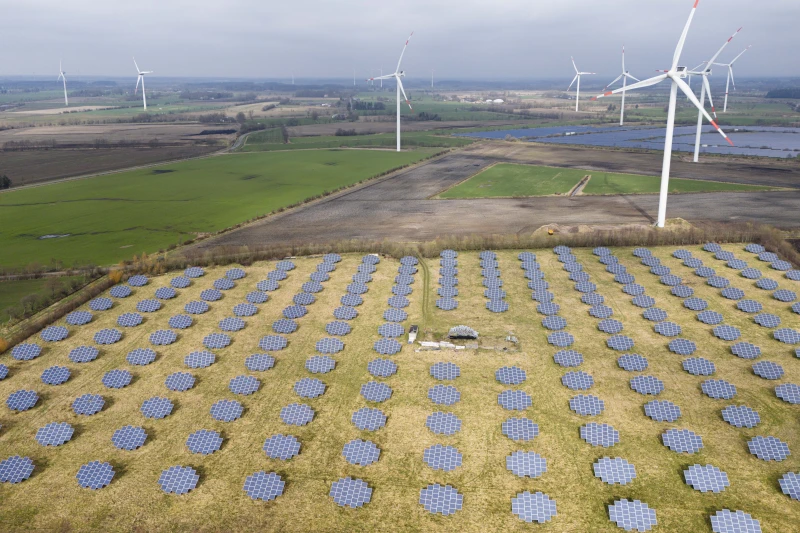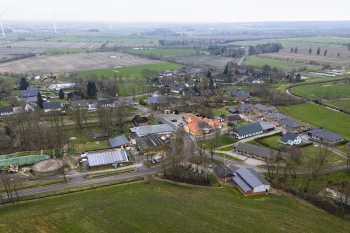The village of Sprakebuell in north Germany is a picturesque rural community that has found prosperity in harnessing the power of wind energy. Situated amidst flat green fields that extend towards the North Sea, the village is not only blessed with natural beauty but also with a lucrative source of income generated by the wind turbines dotting its landscape.
This windfall has not only brought financial benefits to the villagers but has also positioned Sprakebuell as a model for sustainable energy initiatives.
Despite the challenges posed by the global economic landscape post-pandemic, including issues such as high interest rates and inflation, Sprakebuell has managed to thrive by investing in renewable energy projects.
The revenue generated from selling electricity produced by the wind turbines is shared with the local community, providing them with a steady source of income.
This financial stability has empowered the villagers, giving them a sense of security and freedom in planning their future.
Astrid Nissen, a resident of Sprakebuell who manages a dairy farm with her husband, attests to the importance of the wind energy dividends in providing stability amidst the fluctuating milk prices.
The reliable income from the wind parks has not only bolstered the local economy but has also funded community projects such as a new playground, a bike path, and even free piano lessons for the children of Sprakebuell.
The success story of Sprakebuell serves as a beacon of hope in the fight against climate change. As the world strives to increase clean energy capacity to meet ambitious targets set at global summits, the village demonstrates the tangible benefits of investing in renewable energy.
By embracing citizen-owned wind parks and reaping the rewards of sustainable practices, Sprakebuell showcases a model that can be emulated on a larger scale to drive the transition towards a greener future.
In conclusion, the village of Sprakebuell stands as a testament to the transformative power of renewable energy.
Through innovative initiatives and community involvement, Sprakebuell has not only secured its economic prosperity but has also paved the way for a more sustainable future.
As the world grapples with the challenges of climate change, the example set by Sprakebuell serves as a reminder of the positive impact that can be achieved through collective action and a commitment to environmental stewardship.
The recent interest rate hikes by prominent financial institutions such as the U.S. Federal Reserve and the European Central Bank have sparked concerns among economists at University College London.
They are cautioning against the potential negative impacts on the green transition, labeling the high borrowing costs aimed at combating inflation as “terrible news for the green transition.”
According to findings by consultancy Wood Mackenzie, the clean energy sector has faced significant challenges, with calls from governments for increased generating capacity remaining unmet in countries like Germany, Spain, the U.K., and Italy.
This has created hurdles for the advancement of renewable energy initiatives, hindering progress in the transition towards a more sustainable energy landscape.
The repercussions of these developments are particularly severe for lower-income nations, such as those in Africa, where borrowing costs for the substantial initial investments required for renewable energy projects were already prohibitive and have now escalated further.
This exacerbates the financial burden on countries striving to adopt cleaner energy sources and achieve environmental sustainability.
In the village of Sprakebuell, a notable transformation has taken place over the years, with the consolidation of family farms and the emergence of a diverse community that includes residents commuting to work in nearby cities.
The establishment of wind parks in the area, funded through a collaborative effort involving local residents and banks, has not only bolstered renewable energy production but also brought economic benefits to the community.
Individuals like Nissen and her husband have reaped rewards from their early investments in renewable energy, utilizing dividends to improve their farming operations and enhance their quality of life.
The success of projects like the wind parks in Sprakebuell highlights the positive impact that community-driven renewable energy initiatives can have on local economies and livelihoods.
Key factors contributing to the advancement of renewables, as demonstrated by projects like those led by Solar-Energie Andresen GmbH, include government incentives such as guaranteed electricity prices over extended periods and access to low-interest loans from development banks.
However, the recent uptick in interest rates, even for such loans, poses a significant challenge to the continued growth of renewable energy projects.
Unlike fossil fuel ventures, where operational costs are a major component, the bulk of expenses for renewable energy projects are front-loaded in the initial purchase of equipment like wind turbines and solar panels.
Consequently, high borrowing costs resulting from elevated interest rates have a disproportionately adverse effect on renewable energy initiatives, impeding their scalability and adoption.
In conclusion, the current trend of rising interest rates presents a formidable barrier to the expansion of renewable energy projects and the broader green transition.
Addressing these challenges will require concerted efforts from policymakers, financial institutions, and stakeholders to ensure that sustainable energy solutions remain viable and accessible, particularly for communities and regions seeking to embrace cleaner and more environmentally friendly alternatives.
The cost of borrowing plays a pivotal role in determining the profitability of a project. This dynamic is particularly evident in the realm of renewable energy versus fossil fuels.
While constructing a natural gas-fired electricity plant may seem cost-effective initially, the true expenses manifest in the subsequent procurement of gas. Factors such as inflation-induced increases in construction costs and equipment shortages stemming from disrupted supply chains further complicate the financial landscape.
These challenges were underscored by the decisions of companies like Orsted and Vattenfall to cancel or suspend large-scale wind projects. The S&P Global Clean Energy Index has experienced a notable decline over the past year, contrasting with the broader market indexes’ upward trajectory.
In the U.S., fluctuating interest rates have posed obstacles for renewable energy ventures, affecting project returns. Despite this, prospects are looking up, with anticipated rate cuts by the Federal Reserve.
The situation is nuanced, with progress in renewables by oil giants alleviating supply chain bottlenecks, while U.S. subsidy requirements for domestic content contribute to delays.
In regions like sub-Saharan Africa, where electricity access is limited, renewable initiatives face formidable financing hurdles. Solar power, abundant due to ample sunshine, remains underutilized compared to regions like Germany.

High borrowing costs and political uncertainties impede progress, exemplified by stalled solar projects in Nigeria. Government reluctance to guarantee credit from institutions like the World Bank due to concerns about grid reliability further complicates matters.
Strategies to address these challenges include electricity price hikes, as seen in Germany, to bolster project financing. Developed nations can also offer subsidized interest rates and credit guarantees to aid developing countries in combating climate change.
Additionally, community ownership of energy projects can mitigate objections to renewable infrastructure, as local stakeholders are more likely to embrace such developments.
